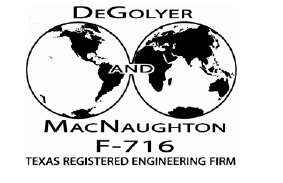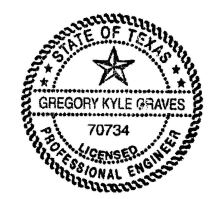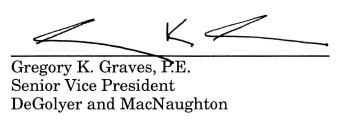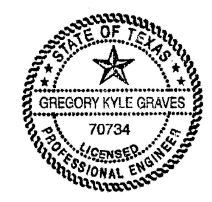Attached files
| file | filename |
|---|---|
| 10-K - 10-K - Oasis Petroleum Inc. | oas-12312017x10k.htm |
| EX-32.2 - EXHIBIT 32.2 - Oasis Petroleum Inc. | oas-12312017xex322.htm |
| EX-32.1 - EXHIBIT 32.1 - Oasis Petroleum Inc. | oas-12312017xex321.htm |
| EX-31.1 - EXHIBIT 31.1 - Oasis Petroleum Inc. | oas-12312017xex311.htm |
| EX-4.15 - EXHIBIT 4.15 - Oasis Petroleum Inc. | oas-12312017xex415.htm |
| EX-4.16 - EXHIBIT 4.16 - Oasis Petroleum Inc. | oas-12312017xex416.htm |
| EX-23.1 - EXHIBIT 23.1 - Oasis Petroleum Inc. | oas-12312017xex231.htm |
| EX-21.1 - EXHIBIT 21.1 - Oasis Petroleum Inc. | oas-12312017xex211.htm |
| EX-23.2 - EXHIBIT 23.2 - Oasis Petroleum Inc. | oas-12312017xex232.htm |
| EX-12.1 - EXHIBIT 12.1 - Oasis Petroleum Inc. | oas-12312017xex121.htm |
| EX-31.2 - EXHIBIT 31.2 - Oasis Petroleum Inc. | oas-12312017xex312.htm |
DeGolyer and MacNaughton
5001 Spring Valley Road
Suite 800 East
Dallas, Texas 75244
This is a digital representation of a DeGolyer and MacNaughton report.
Each file contained herein is intended to be a manifestation of certain data in the subject report and as such is subject to the definitions, qualifications, explanations, conclusions, and other conditions thereof. The information and data contained in each file may be subject to misinterpretation; therefore, the signed and bound copy of this report should be considered the only authoritative source of such information.
 | ||||
DeGolyer and MacNaughton
5001 Spring Valley Road
Suite 800 East
Dallas, Texas 75244
January 30, 2018
Oasis Petroleum Inc.
1001 Fannin, Suite 1500
Houston, Texas 77002
Ladies and Gentlemen:
Pursuant to your request, we have prepared estimates of the extent and value of the net proved oil and gas reserves, as of December 31, 2017, of certain properties in which Oasis Petroleum Inc. (Oasis) has represented that it owns an interest. This evaluation was completed on January 30, 2018. The properties evaluated consist of working and royalty interests located in the States of Montana and North Dakota. Oasis has represented that these properties account for 100 percent on a net equivalent barrel basis of Oasis’ net proved reserves as of December 31, 2017, and that the net proved reserves estimates have been prepared in accordance with the reserves definitions of Rules 4–10(a) (1)–(32) of Regulation S–X of the Securities and Exchange Commission (SEC) of the United States. This report was prepared in accordance with guidelines specified in Item 1202 (a)(8) of Regulation S–K and is to be used for inclusion in certain SEC filings by Oasis.
Reserves estimates included herein are expressed as net reserves. Gross reserves are defined as the total estimated petroleum to be produced from these properties after December 31, 2017. Net reserves are defined as that portion of the gross reserves attributable to the interests owned by Oasis after deducting all interests owned by others.
Estimates of oil and gas reserves and future net revenue should be regarded only as estimates that may change as further production history and additional information become available. Not only are such reserves estimates based on that information which is currently available, but such estimates are also subject to the uncertainties inherent in the application of judgmental factors in interpreting such information.
3
DeGolyer and MacNaughton
Data used in this evaluation were obtained from reviews with Oasis personnel, from Oasis files, from records on file with the appropriate regulatory agencies, and from public sources. In the preparation of this report we have relied, without independent verification, upon such information furnished by Oasis with respect to property interests, production from such properties, current costs of operation and development, current prices for production, agreements relating to current and future operations and sale of production, and various other information and data that were accepted as represented. A field examination of the properties was not considered necessary for the purposes of this report.
Methodology and Procedures
Estimates of reserves were prepared by the use of appropriate geologic, petroleum engineering, and evaluation principles and techniques that are in accordance with practices generally recognized by the petroleum industry, which are presented in the publication of the Society of Petroleum Engineers PRMS and publications of the Society of Petroleum Evaluation Engineers Monograph III and IV.
A performance-based methodology integrating the appropriate geology and petroleum engineering data was utilized for the evaluation of all reserves categories. Performance-based methodology primarily includes (1) production diagnostics, (2) decline-curve analysis, and (3) model-based analysis (if necessary, based on availability of data). Production diagnostics include data quality control, identification of flow regimes, and characteristic well performance behavior. Analysis was performed for all well groupings (or type-curve areas).
Characteristic rate-decline profiles from diagnostic interpretation were translated to modified hyperbolic rate profiles, including one or multiple b-exponent values followed by an exponential decline. Based on the availability of data, model-based analysis may be integrated to evaluate long-term decline behavior, the impact of dynamic reservoir and fracture parameters on well performance, and complex situations sourced by the nature of unconventional reservoirs. The methodology used for the analysis was tempered by experience with similar reservoirs, stage of development, quality and completeness of basic data, production history, and the appropriate reserves definitions.
In certain cases, when the previously named methods could not be used, reserves were estimated by analogy with similar wells or reservoirs for which more complete data were available.
Based on the current stage of field development, production performance, the development plans provided by Oasis, and the analyses of areas offsetting existing wells with test or production data, reserves were classified as proved.
4
DeGolyer and MacNaughton
Oasis has represented that its senior management is committed to the development plan provided by Oasis and that Oasis has the financial capability to drill the locations as scheduled in its development plan.
Gas quantities estimated herein are expressed as sales gas. Sales gas is defined as the total gas to be produced from the reservoirs, measured at the point of delivery, after reduction for fuel use, flare, and shrinkage resulting from field separation and processing. Gas reserves are expressed at a temperature base of 60 degrees Fahrenheit and at a pressure base of 14.73 pounds per square inch absolute. Gas reserves included herein are expressed in thousands of cubic feet (Mcf). Oil reserves estimated herein are those to be recovered by conventional lease separation. Oil reserves included herein are expressed in barrels (bbl) representing 42 United States gallons per barrel.
Definition of Reserves
Petroleum reserves included in this report are classified as proved. Only proved reserves have been evaluated for this report. Reserves classifications used in this report are in accordance with the reserves definitions of Rules 4–10(a) (1)–(32) of Regulation S–X of the SEC. Reserves are judged to be economically producible in future years from known reservoirs under existing economic and operating conditions and assuming continuation of current regulatory practices using conventional production methods and equipment. In the analyses of production‑decline curves, reserves were estimated only to the limit of economic rates of production under existing economic and operating conditions using prices and costs consistent with the effective date of this report, including consideration of changes in existing prices provided only by contractual arrangements but not including escalations based upon future conditions. The petroleum reserves are classified as follows:
Proved oil and gas reserves – Proved oil and gas reserves are those quantities of oil and gas, which, by analysis of geoscience and engineering data, can be estimated with reasonable certainty to be economically producible—from a given date forward, from known reservoirs, and under existing economic conditions, operating methods, and government regulations—prior to the time at which contracts providing the right to operate expire, unless evidence indicates that renewal is reasonably certain, regardless of whether deterministic or probabilistic methods are used for the estimation. The project to extract the hydrocarbons must have commenced or the operator must be reasonably certain that it will commence the project within a reasonable time.
(i) The area of the reservoir considered as proved includes:
5
DeGolyer and MacNaughton
(A) The area identified by drilling and limited by fluid contacts, if any, and (B) Adjacent undrilled portions of the reservoir that can, with reasonable certainty, be judged to be continuous with it and to contain economically producible oil or gas on the basis of available geoscience and engineering data.
(ii) In the absence of data on fluid contacts, proved quantities in a reservoir are limited by the lowest known hydrocarbons (LKH) as seen in a well penetration unless geoscience, engineering, or performance data and reliable technology establishes a lower contact with reasonable certainty.
(iii) Where direct observation from well penetrations has defined a highest known oil (HKO) elevation and the potential exists for an associated gas cap, proved oil reserves may be assigned in the structurally higher portions of the reservoir only if geoscience, engineering, or performance data and reliable technology establish the higher contact with reasonable certainty.
(iv) Reserves which can be produced economically through application of improved recovery techniques (including, but not limited to, fluid injection) are included in the proved classification when:
(A) Successful testing by a pilot project in an area of the reservoir with properties no more favorable than in the reservoir as a whole, the operation of an installed program in the reservoir or an analogous reservoir, or other evidence using reliable technology establishes the reasonable certainty of the engineering analysis on which the project or program was based; and (B) The project has been approved for development by all necessary parties and entities, including governmental entities.
(v) Existing economic conditions include prices and costs at which economic producibility from a reservoir is to be determined. The price shall be the average price during the 12‑month period prior to the ending date of the period covered by the report, determined as an unweighted arithmetic average of the first-day-of-the-month price for each month within such period, unless prices are defined by contractual arrangements, excluding escalations based upon future conditions.
Developed oil and gas reserves – Developed oil and gas reserves are reserves of any category that can be expected to be recovered:
6
DeGolyer and MacNaughton
(i) Through existing wells with existing equipment and operating methods or in which the cost of the required equipment is relatively minor compared to the cost of a new well; and
(ii) Through installed extraction equipment and infrastructure operational at the time of the reserves estimate if the extraction is by means not involving a well.
Undeveloped oil and gas reserves – Undeveloped oil and gas reserves are reserves of any category that are expected to be recovered from new wells on undrilled acreage, or from existing wells where a relatively major expenditure is required for recompletion.
(i) Reserves on undrilled acreage shall be limited to those directly offsetting development spacing areas that are reasonably certain of production when drilled, unless evidence using reliable technology exists that establishes reasonable certainty of economic producibility at greater distances.
(ii) Undrilled locations can be classified as having undeveloped reserves only if a development plan has been adopted indicating that they are scheduled to be drilled within five years, unless the specific circumstances justify a longer time.
(iii) Under no circumstances shall estimates for undeveloped reserves be attributable to any acreage for which an application of fluid injection or other improved recovery technique is contemplated, unless such techniques have been proved effective by actual projects in the same reservoir or an analogous reservoir, as defined in [section 210.4–10 (a) Definitions], or by other evidence using reliable technology establishing reasonable certainty.
The development status shown herein represents the status applicable on December 31, 2017. In the preparation of this study, data available from wells drilled on the evaluated properties through December 31, 2017, were used in estimating gross ultimate recovery. When applicable, gross production estimated through December 31, 2017, was deducted from gross ultimate recovery to arrive at the estimates of gross reserves. In some fields this required that the production rates be estimated for up to 2 months, since production data from certain properties were available only through October 2017.
7
DeGolyer and MacNaughton
Primary Economic Assumptions
Revenue values in this report are expressed in terms of estimated future gross revenue, future net revenue, and present worth of future net revenue. Future gross revenue is defined as that revenue to be realized from the production and sale of the estimated net reserves. Future net revenue is calculated by deducting estimated production taxes, operating expenses, capital costs, and abandonment costs from the future gross revenue. Operating expenses include field operating expenses, transportation expenses, compression charges, and an allocation of overhead that directly relates to production activities. Future income tax expenses were not taken into account in the preparation of these estimates. Present worth of future net revenue is calculated by discounting the future net revenue at the arbitrary rate of 10 percent per year compounded monthly over the expected period of realization. Present worth should not be construed as fair market value because no consideration was given to additional factors that influence the prices at which properties are bought and sold.
Revenue values in this report were estimated using prices and costs provided by Oasis. Future prices were estimated using guidelines established by the SEC and the Financial Accounting Standards Board (FASB). The prices used in this report were based on SEC guidelines. The following economic assumptions were used for estimating existing and future prices and costs:
Oil Prices
Oasis has represented that the oil prices were based on a reference price, calculated as the unweighted arithmetic average of the first-day-of-the-month price for each month within the 12-month period prior to the end of the reporting period, unless prices are defined by contractual arrangements. Oasis supplied differentials for each property to a West Texas Intermediate reference price of $51.34 per barrel and the prices were held constant thereafter. The volume-weighted average oil price attributable to the estimated proved reserves was $45.17 per barrel.
Gas Prices
Oasis has represented that the gas prices were based on a Henry Hub price, calculated as the unweighted arithmetic average of the first-day-of-the-month price for each month within the 12-month period prior to the end of the reporting period, unless prices are defined by contractual arrangements. The gas prices were calculated for each property using differentials to the Henry Hub price of $2.99 per million British thermal units ($/MMBtu) furnished by Oasis and held constant thereafter. These differentials include revenue from the sale of natural gas liquids attributable to Oasis.
8
DeGolyer and MacNaughton
British thermal unit factors were provided by Oasis and used to convert prices from $/MMBtu to dollars per thousand cubic feet. The volume‑weighted average gas price attributable to the estimated proved reserves was $2.815 per thousand cubic feet.
Production and Ad Valorem Taxes
Production taxes were calculated using the tax rates for the state in which the reserves are located. Per Oasis, these properties are not subject to ad valorem taxes; therefore, ad valorem taxes have not been applied to the reserves evaluated herein.
Operating Expenses, Capital Costs, and Abandonment Costs
Estimates of operating expenses, provided by Oasis and based on current expenses, were held constant for the lives of the properties. Future capital expenditures were estimated using 2017 values, provided by Oasis, and were not adjusted for inflation. Abandonment costs, which are those costs associated with the removal of equipment, plugging of the wells, and reclamation and restoration associated with the abandonment, were provided by Oasis for all properties.
Oasis has represented that the properties reviewed by us account for 100 percent on a net equivalent barrel basis of Oasis’ net proved reserves as of December 31, 2017. Our estimates of Oasis’ net proved reserves attributable to the reviewed properties were based on the definition of proved reserves of the SEC and are summarized as follows, expressed in thousands of barrels (Mbbl), millions of cubic feet (MMcf), and thousands of barrels of oil equivalent (Mboe):
Estimated by DeGolyer and MacNaughton Net Proved Reserves as of December 31, 2017 | ||||||
Oil (Mbbl) | Sales Gas (MMcf) | Oil Equivalent (Mboe) | ||||
Proved Developed | 150,628 | 301,101 | 200,812 | |||
Proved Undeveloped | 74,332 | 222,355 | 111,391 | |||
Total Proved | 224,960 | 523,456 | 312,203 | |||
Note: Gas is converted to oil equivalent using a factor of 6,000 cubic feet of gas per 1 barrel of oil equivalent. | ||||||
9
DeGolyer and MacNaughton
The estimated future revenue and expenditures attributable to the production and sale of Oasis’ net proved reserves of the properties evaluated, as of December 31, 2017, are summarized as follows, expressed in thousands of dollars (M$):
Proved Developed (M$) | Proved Undeveloped (M$) | Total Proved (M$) | ||||
Future Gross Revenue | 7,656,045 | 3,980,081 | 11,636,126 | |||
Production Taxes | 683,717 | 349,536 | 1,033,253 | |||
Operating Expenses | 2,719,954 | 705,211 | 3,425,165 | |||
Capital Costs | 15,251 | 894,661 | 909,912 | |||
Abandonment Costs | 70,501 | 11,858 | 82,359 | |||
Future Net Revenue | 4,166,622 | 2,018,815 | 6,185,437 | |||
Present Worth at 10 Percent | 2,600,431 | 1,083,309 | 3,683,740 | |||
Note: Future income taxes have not been taken into account in the preparation of these estimates. | ||||||
While the oil and gas industry may be subject to regulatory changes from time to time that could affect an industry participant’s ability to recover its reserves, we are not aware of any such governmental actions which would restrict the recovery of the December 31, 2017, estimated proved reserves.
In our opinion, the information relating to estimated proved reserves, estimated future net revenue from proved reserves, and present worth of estimated future net revenue from proved reserves of oil and gas contained in this report has been prepared in accordance with Paragraphs 932‑235-50-4, 932-235-50-6,
932-235-50-7, 932-235-50-9, 932-235-50-30, and 932‑235-50-31(a), (b), and (e) of the Accounting Standards Update 932-235-50, Extractive Industries – Oil and Gas (Topic 932): Oil and Gas Reserve Estimation and Disclosures (January 2010) of the Financial Accounting Standards Board and Rules 4–10(a) (1)–(32) of Regulation S–X and Rules 302(b), 1201, 1202(a) (1), (2), (3), (4), (8), and 1203(a) of Regulation S–K of the Securities and Exchange Commission; provided, however, that (i) future income tax expenses have not been taken into account in estimating the future net revenue and present worth values set forth herein and (ii) estimates of the proved developed and proved undeveloped reserves are not presented at the beginning of the year.
932-235-50-7, 932-235-50-9, 932-235-50-30, and 932‑235-50-31(a), (b), and (e) of the Accounting Standards Update 932-235-50, Extractive Industries – Oil and Gas (Topic 932): Oil and Gas Reserve Estimation and Disclosures (January 2010) of the Financial Accounting Standards Board and Rules 4–10(a) (1)–(32) of Regulation S–X and Rules 302(b), 1201, 1202(a) (1), (2), (3), (4), (8), and 1203(a) of Regulation S–K of the Securities and Exchange Commission; provided, however, that (i) future income tax expenses have not been taken into account in estimating the future net revenue and present worth values set forth herein and (ii) estimates of the proved developed and proved undeveloped reserves are not presented at the beginning of the year.
To the extent the above-enumerated rules, regulations, and statements require determinations of an accounting or legal nature, we, as engineers, are necessarily unable to express an opinion as to whether the above-described information is in accordance therewith or sufficient therefor.
10
DeGolyer and MacNaughton
DeGolyer and MacNaughton is an independent petroleum engineering consulting firm that has been providing petroleum consulting services throughout the world since 1936. DeGolyer and MacNaughton does not have any financial interest, including stock ownership, in Oasis. Our fees were not contingent on the results of our evaluation. This letter report has been prepared at the request of Oasis. DeGolyer and MacNaughton has used all assumptions, data, procedures, and methods that it considers necessary and appropriate to prepare this report.
Submitted,
 | |||||
 | |||||
 | |||||
DeGolyer and MacNaughton
CERTIFICATE of QUALIFICATION
I, Gregory K. Graves, Petroleum Engineer with DeGolyer and MacNaughton, 5001 Spring Valley Road, Suite 800 East, Dallas, Texas, 75244 U.S.A., hereby certify:
1. | That I am a Senior Vice President with DeGolyer and MacNaughton, which company did prepare the letter report addressed to Oasis dated |
January 30, 2018, and that I, as Senior Vice President, was responsible for the preparation of this letter report.
2. | That I attended the University of Texas at Austin, and that I graduated with a Bachelor of Science degree in Petroleum Engineering in the year 1984; that I am a Registered Professional Engineer in the State of Texas; that I am a member of the Society of Petroleum Engineers and the Society of Petroleum Evaluation Engineers; and that I have in excess of 33 years of experience in oil and gas reservoir studies and reserves evaluations. |
 | ||||
 | ||||
